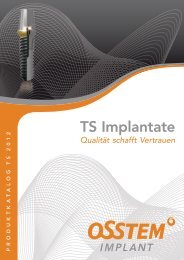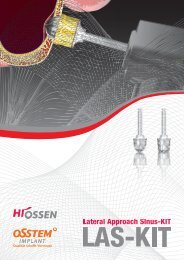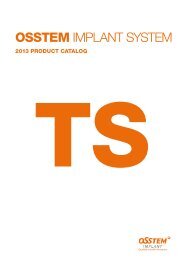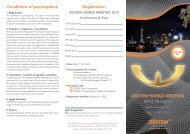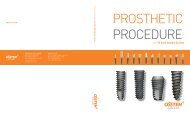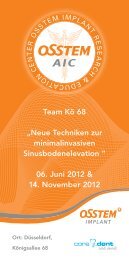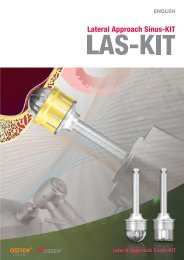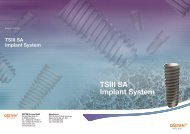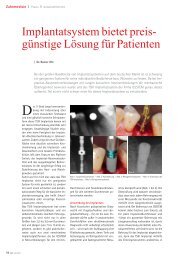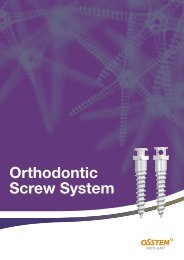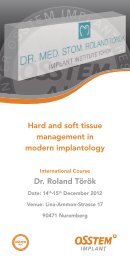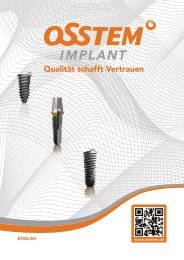Heat Transfer to the Implant-Bone Interface duringpreparation of Zirconia/Alumina Complex AbutmentFatigue Fracture of Different Dental Implant <strong>System</strong> Under CyclicLoadingJung-Bo Huh, Steven E. Eckert, Seok-Min Ko, Yong-Geun ChoiiInt J Oral Maxillofac Implants 2009;24:679-83Won-Ju Park, In-Ho ChoJ Kor Acad Prosthodont 2009;47:424-34US <strong>System</strong> Pre-Clinical StudyPurpose:Excessive heat at the implant-bone interface may compromiseosseointegration. , This study examined heat generated at the implantsurface during preparation of zirconia/alumina complex abutment in vitro.Material & Methods:Sixty zirconia/alumina complex abutments (ZioCera , OSSTEM, Seoul,Korea) were randomized to twelve experiment groups. Theabutments were connected to implant (US II, OSSTEM, Seoul, Korea)and were embedded in an acrylic-resin block in a 37℃ water bath.Abutments were reduced horizontally 1mm height over a period of 1minute with highspeed handipiece and polished for 30 seconds withlowspeed handpiece “with air/water coolant” and “without coolant.”Temperatures were recorded via thermocouples at the cervical,middle, and apical part of the implant surface. The Mann-Whitneyrank-sum test was used to assess the statistical significance ofdifference of temperature between with coolant and without coolant.Fig. 1. US II Plus implant(Diameter:4.0mm, Length:13mm).AcrylicResinBlockZirAceAbutmentUS IIFixtureFig. 2. ZioCera Abutment (Platform:regular, Height: 5.5mm, collar:5.0mm).Thermocouple : Cervical AreaThermocouple : Middle AreaThermocouple : ApexFig. 3. Schematic of locations of three temperature sensors.Fig. 4. Temperature monitoring system: LabView (National Instrument,Texas, US), PXI6259 (National Instrument, Texas, US).Results:1mm reduction with highspeed handpiece without coolant resulted inmaximum temperature of 41.22℃ at the cervical of implant. 3 of 4temperatures more than 40℃ were observed at the cervical part ofimplant with highspeed handpiece without coolant. Temperaturedifference between “with coolant” and “without coolant” during bothlowspeed polishing and highspeed reduction was statisticallysignificant at the cervix of implant (p = 0.009). In contrast, temperaturedifference between “with coolant” and “without coolant” during bothlowspeed polishing and highspeed reduction was not statisticallysignificant at the middle and apical part of implant (p > .05).Conclusions:Preparation of zirconia/alumina complex abutment caused an increasein temperature within the implant but this temperature increase didnot reach critical levels described in implant literature.Table 1. Temperatures at each location of implant during preparation of fiveabutments using each handpiece type accompanied with coolant and without coolantExperiment HandpieceCoolant LocationAbutment Abutment Abutment Abutment AbutmentGroup type1 (℃) 2 (℃) 3 (℃) 4 (℃) 5 (℃)1 High Yes Cervical 38.58 37.50 38.90 37.80 38.582 High Yes Middle 37.80 37.50 37.02 36.69 37.213 High Yes Apical 37.50 37.39 37.02 36.33 37.214 High No Cervical 41.22 40.22 38.99 40.10 39.585 High No Middle 37.15 38.00 36.98 37.55 37.126 High No Apical 37.15 37.69 36.98 37.50 37.017 Low Yes Cervical 37.55 37.56 37.89 37.11 37.008 Low Yes Middle 37.01 37.00 36.98 37.45 37.699 Low Yes Apical 37.01 36.99 36.98 37.45 37.6910 Low No Cervical 39.33 38.52 39.12 38.20 40.0111 Low No Middle 37.08 37.96 37.45 37.45 37.2312 Low No Apical 37.08 37.93 37.40 37.10 37.00Table 2. Mean temperature and statistical significance of temperaturedifference for Zirconia/Alumina Complex abutment with highspeed contouringLocationCervicalMiddleApicalCoolant Mean temperature±SDYes 38.27±0.59No 40.02±0.83Yes 37.24±0.43No 37.36±0.42Yes 37.09±0.46No 37.27±0.31Statisticalsignificance (p-value)0.0090.7540.834Table 3. Mean temperature and statistical significance of temperaturedifference for Zirconia/Alumina Complex abutment with lowspeed polishingLocation Coolant Mean temperature±SDStatisticalsignificance (p-value)CervicalYes 37.42±0.36No 39.04±0.710.009MiddleYes 37.23±0.33No 37.43±0.330.245ApicalYes 37.22±0.33No 37.30±0.380.465Conclusions:Preparation of zirconia/alumina complex abutment caused an increasein temperature within the implant but this temperature increase didnot reach critical levels described in implant literature.Purpose:Implant has weak mechanical properties against lateralloading compared to vertical occlusal loading, andtherefore, stress analysis of implant fixture depending onits material and geometric features is needed.Materials and Methods:Total 28 of external hexed implants were divided into 7 of 4groups; Group A (3i, FULL OSSEOTITE Implant), Group B(Nobelbiocare, Bra nemark <strong>System</strong> Mk III Groovy RP),Group C (Neobiotec, SinusQuick TM EB), Group D (<strong>Osstem</strong>,USII). The type III gold alloy prostheses were fabricatedusing adequate UCLA gold abutments. Fixture, abutmentscrew, and abutment were connected and cross-sectionedvertically. Hardness test was conducted using MXT-α. Forfatigue fracture test, with M<strong>TS</strong> 810, the specimens wereloaded to the extent of 60 - 600 N until fracture occurred.The fracture pattern of abutment screw and fixture wasobserved under scanning electron microscope. Acomparative study of stress distribution and fracture areaof abutment screw and fixture was carried out throughfinite element analysis.Group Manufacturer Implant Type Abutment Abut. screwA 3i Implant Innovations Inc., FL, USA FULL OSSEOTITE External UCLA Gold Standard ZRTM Gold tite TMB Novel biocare AB, Goteburg, Sweden Mk III Groovy RP External Gold Adapt Engaging Branemark <strong>System</strong> RP Torqtite TMC Neobiotec Co., Ltd., Seoul, Korea SinusQuick TM EB External Gold UCLA Gold Abutment regular/single TitaniumD <strong>Osstem</strong> Co., Ltd., Seoul, Korea US-II External US UCLA Gold Abutment Ebony GoldResults:1. In Vicker’s hardness test of abutment screw, the highestvalue was measured in group A and lowest value wasmeasured in group D.2. In all implant groups, implant fixture fractures occurredmainly at the 3 - 4th fixture thread valley where tensilestress was concentrated. When the fatigue life wascompared, significant difference was found between thegroup A, B, C and D (p < .05).3. The fracture patterns of group B and group D showedcomplex failure type, a fracture behavior includingtransverse and longitudinal failure patterns in both fixtureand abutment screw. In Group A and C, however, thetransverse failure of fixture was only observed.4. The finite element analysis infers that a fatigue crackstarted at the fixture surface.Fig 1. Mean fatigue life of each implant.Fig. 2. SEM picture of fractured surface of A, B, C and D implant.Fig. 3. SEM picture of fracturedsurface of B implant.Fig. 4. SEM picture of fracture surfaceof B abutment screw.Fig. 5. Stress distribution of implant under 600 N loading in 30 angle.Conclusions:The maximum tensile stress was found in the implantfixture at the level of cortical bone. The fatigue fractureoccurred when the dead space of implant fixture coincideswith jig surface where the maximum tensile stress wasgenerated. To increase implant durability, prevention ofsurrounding bone resorption is important. However, if thebone resorption progresses to the level of dead space, thefrequency of implant fracture would increase. Thus, propermanagement is needed.US <strong>System</strong> Pre-Clinical Study5859
US <strong>System</strong> ReferencesUS <strong>System</strong> ReferencesClinical Study1. Sun-Keun Kim, Jee-Hwan Kim, Keun-Woo Lee, Kyoo-Sung Cho, Dong-Hoo Han. Success Rate and Marginal Bone Loss of <strong>Osstem</strong> USII plusImplants; Short term Clinical Study. J Korean Acad Prosthodont2011;49(3):206-13.2. Su-Won Park, Soo-Mi Jang, Byoung-Hwan Choi, Han-Na Son, Bong-chanPark, Chang-Hwan Kim, Jang-Ho Son, Iel-Yong Sung, Ji-Ho Lee, Yeong-Cheol Cho. The Study of Bone Density Assessment on Dental ImplantSites. J Korean Assoc Oral Maxillofac Surg 2010;36(5):417-223. Young-Kyun Kim, Pil-Young Yun, Su-Gwan Kim, Bum-Soo Kim, Joo LOng. Evaluation of Sinus Bone Resorption and Marginal Bone Loss afterSinus Bone Grafting and Implant Placement. Oral Surg Oral Med OralPathol Oral Radiol Endod 2009;107:e21-8.4. Bum-Soo Kim, Young-Kyun Kim, Pil-Young Yun, Yang-Jin Yi, Hyo-JeongLee, Su-Gwan Kim, Jun-Sik Son. Evaluation of Peri-implant TissueResponse according to the Presence of Keratinized Mucosa. Oral SurgOral Med Oral Pathol Oral Radiol Endod 2009;107:e24-8 .5. Young-Dai Song, Sang-Ho Jun, Jong-Jin Kwon. Correlation BetweenBone Quality Evaluated by Cone-Beam Computerized Tomography andImplant Primary Stability. Int J Oral Maxillofac Implants 2009;24(1):59-64.6. Mi-A Kwon, Yong-Deok Kim, Chang-Mo Jeong, Ju-Youn Lee. Clinical andRadiographic Evaluation of Implants with Dual-microthread: 1-year Study.J Korean Acad Periodontol 2009;39(1):27-36.7. Jang-Ho Son, Byung-hwan Choi, Soo-Won Park, Yeong-Cheol Cho, Iel-Yong Sung, Ji-Ho Lee, Ki-Jung Byun. Bone Density andHistomorphometry Assessment of Dental Implant Using ComputerizedTomography. J Korean Assoc Maxillofac Plast Reconstr Surg2009;31(2):137-46.8. Hyun-Joo Kim, Woon-Jung Noh, Seung-Il Song, Sok-Min Ko. ImplantReplacement Utilizing Zirconia Abutment in Esthetic Zone. J KoreanImplantology(KAOMI) 2009;13(2):16-24.9. Seong-Yeon Lee, Young-Kyun Kim, Pil-Young Yun, Yang-jin Yi, In-SungYeo, Hyo-Jung Lee, Ji-Young Lee. Prospective Clinical Study of ShortImplant. Scientific Poster, 4th Congress of the ICOI Korea 2009.10. Moo-Gyung Sung. User Guide of <strong>Osstem</strong> Implant <strong>System</strong>s. ScientificOral, The 50th Anniversary of KAP, International ProsthodonticCongress & The 6th Biennial Meeting of Asian Academy ofProsthodontics (AAP) 2009.11. Sung-Moon Back, Min-Suk Oh, Su-Kwan Kim. A Retrospective Studyon the Clinical Success Rate of <strong>Osstem</strong> Implant. Key EngineeringMaterials 2008;361-3:1331-412. Hong-Ju Park, Min-Suk Kook, Su-Gwan Kim, Young-Kyun Kim, Yong-Seok Cho, Gab-Lim Choi, Young-Hak Oh, Hee-Kyun Oh. MulticenterRetrospective Study of Immediate Two Different RBM SurfacedImplant <strong>System</strong>s after Extraction. J Korean Assoc Maxillofac PlastReconstr Surg 2008;30(3):258-65.13. Min-Suk Kook, Hong-Ju Park, Su-Gwan Kim, Young-Kyun Kim, Yong-Seok Cho, Gab-Lim Choi, Young-Hak Oh, Hee-Kyun Oh. ARetrospective Multicenter Clinical Study of Installed US II / SS IIImplants after Maxillary Sinus Floor Elevation. J Kor Oral Maxillofac Surg2008;34:341-9.14. Young-Kyun Kim, Pil-Young Yun, Jae-Hyung Im. Clinical RetrospectiveStudy of Sinus Bone Graft and Implant Placement. J Korean AssocMaxillofac Plast Reconstr Surg 2008;30(3):294-302.15. Se-Il Ki, Min-Gi Yu, Young-Joon Kim, Min-Suk Kook, Hong-Ju Park,Uttom Kumar Shet, Hee-Kyun Oh. A Retrospective Evaluation ofImplant Installation with Maxillary Sinus Augmentation by LateralWindow Technique. J Korean Assoc Maxillofac Plast Reconstr Surg2008;30(5):457-64.16. Young-Kyun Kim, Pil-Young Yun, Min-Jung Kwon. Short termRetrospective Clinical Study on GS II, SS III, US III. J KoreanImplantology(KAOMI) 2008;12(2):12-22.17. Kang-Woo Kim, Jae-Kwan Lee, Heung-Sik Um, Beom-Seok Chang.Soft-tissue Management for Primary Closure in Immediate ImplantPlacement. J Korean Acad Periodontol 2008;38(2):253-62 .18. Bum-Soo Kim, Young-Kyun Kim, Pil-Young Yun, Yang-Jin Lee. ClinicalEvaluation of Sinus Bone Graft Using Allograft and Xenograft. ScientificPoster, 17th Annual Scientific Congress of EAO 2008.19. Seo-Yoon Kim, Su-Gwan Kim, Hak-Kyun Kim. A Comparision betweenthe Survival Rate of RBM surface implants and Acid-etched surfaceimplants : A prospective 1-year Clinical Study. Scientific Poster, J KorOral Maxillofac Surg 2008; 34 (Suppl).20. Uttom Kumar Shet, Min-Suk Kook, Hong-Ju Park, Hee-Kyun Oh.Comparison of Bone Resorption Between Autogenous Bone Graft andDistraction Osteogenesis with Others Treatment Outcome. ScientificPoster, J Kor Oral Maxillofac Surg 2008; 34 (Suppl).21. Su-Gwan Kim, Chul-Min Park, Young-Kyun Kim, Hee-Kyun Oh, Gab-LimChoi, Young-Hak Oh. Multicenter Retrospective Clinical Study of<strong>Osstem</strong> US II Implant <strong>System</strong> in Type IV Bone. J KoreanImplantology(KAOMI) 2007;11(3):22-9.22. Su-Gwan Kim, Min-Suk Oh, Young-Kyun Kim, Hee-Kyun Oh, Gab-LimChoi, Young-Hak Oh.Multicenter Retrospective Clinical Study of<strong>Osstem</strong> US II Implant <strong>System</strong> in Complete Edentulous Patients.JKorean Implantology(KAOMI) 2007;11(3):12-21.23. Young-Kyun Kim. Inferior Alveolar Nerve Repositioning and ImplantPlacement: Case Reports. J Korean Implantology(KAOMI)2007;11(2):42-50.24. Min-Seok Oh, Su-Gwan Kim, Hak-Kyun Kim, Seong-Yong Moon.Restoration of the Mandibular Overdenture Using <strong>Osstem</strong> Implants.Scientific Poster, 2nd Congress of the ICOI Korea 2007.25. Seok-Min Ko, Jeong-Keun Lee, Steven E. Eckert, Yong-Geun Choi.Retrospective Multicenter Cohort Study of the Clinical Performance of2-stage Implants in South Korean Populations. Int J Oral & MaxillofacImplants 2006;21(5):785-8.26. Young-Kyun Kim, Pil-Young Yun, Dae-Il Son, Bum-Soo Kim, Jung-WonHwang. Analysis of Clinical Application of <strong>Osstem</strong> (Korea) Implant<strong>System</strong> for 6 Years. J Korean Implantology(KAOMI) 2006;10(1):56-65.27. Ju-Rim Sun, Su-Gwan Kim, Hee-Yeon Choi, Jong-Woon Kim, Ho-BinLee, Jung-Yeop Park,No-Seung Park, Sang-Yeol Kim, Su-Kwon Kim, Ki-Pyo No, Young-Hoon Won. US II Implantation Using SimPlant Softwarein a Maxillary Edentulous Patient; A Case Report. J KoreanImplantology(KAOMI) 2006;10(3):28-3728. Sun-Hee Oh, Taek-Ga Kwon, Young-Kyun Kim, Jung-Won Hwang.Retrospective Study of <strong>Osstem</strong> Dental Implants; Clinical andRadiographic Results of 2.5 Years. Scientific Poster, 15th AnnualScientific Congress of EAO 2006.29. Jin-Hwan Kim, Dong-Uk Jung. Vertical Ridge Augmentation andImplant Placement in Severe Bone Loss Area with Autogenous Boneand Bovine Bone. Scientific Poster, 1st Congress of the ICOI Korea2006.30. Young-Kyun Kim, Jung-Won Hwang, Pil-Young Yun, Su-Gwan Kim,Chae-Heon Chung, Yong-Gun Choi, Sung-Il Song. MulticentricProspective Clinical Study of Korean Implant <strong>System</strong>: Early StabilityMeasured by Periotest. J Korean Dent Assoc 2004;42(12): 873-81.31. Ki-Yoon Nam, Beon-Seok Chang, Heung-Sik Um. Retrospective ClinicalStudy of Domestic Dental Implant Success Rates. J Korean AcadPeriodontol 2003;33(1):37-47.32. Jai-Bong Lee, Young-Soo Wang, Kwang-Ho Shin, Byung-Nam Hwang.Retrospective Multicenter Study of <strong>Osstem</strong> Endosseous DentalImplant. J Korean Dent Assoc 2000;38(6): 558-66.Pre-Clinical StudyBiology1. Min-Suk Kook, Seung-Gon Jung, Kyung-Mi Shim, Seong-Soo Kang,Hong-Ju Park, Sun-Youl Ryu, Hee-Kyun Oh. The Effect of Platelet RichPlasma in Bone Formation on Implant Installation in the Tibia of BeagleDogs. J Korean Assoc Oral Maxillofac Surg 2010;36:71-7.2. Jee-Hyun Park, Sun-Jung Hwang, Myung-Jin Kim. Effect ofrhPDGF-BB and rhBMP-2 on Osseointegration of TitaniumImplants at Periimplant Bone Defects Grafted with Hydroxyapatite:Micro-CT and Histologic Analysis. J Korean Assoc Maxillofac PlastReconstr Surg 2009;31(6):461-8.3. Ji-Su Oh, Su-Gwan Kim, Sung-Chul Lim, Joo L. Ong. A ComparativeStudy of Two Noninvasive Techniques to Evaluate Implant Stability:Periotest and Osstell Mentor. Oral Surg Oral Med Oral Pathol Oral RadiolEndod 2009;107:513-8.4. Hong-Cheol Yoon, Jung-Yoo Choi, Ui-Won Jung, Eun-Kyung Bae, Seong-Ho Choi, Kyoo-Sung Cho, Ho-Yong Lee, Chong-Kwan Kim, June-SungShim. Effects of Different Depths of Gap on Healing of SurgicallyCreated Coronal Defects around Implants in Dogs: A Pilot Study. JPeriodontol 2008;79(2):355-61.5. Seong-Yong Moon, Su-Gwan Kim, Sung-Chul Lim, Joo L. Ong.Histologic and Histomorphometric Evaluation of Early and ImmediatelyLoaded Implants in the Dog Mandible. J Biomed Mater Res2008;86A:1122-7.6. Jeong-Wan Ha, Su-Gwan Kim. Histomorphometric Analysis of anImmediate Non-functional Loaded Implant in Dogs. J Korean Assoc OralMaxillofac Surg 2008;34:90-4.7. Jin-Yong Cho, Young-Jun Kim, Min-Gi Yu, Min-Suk Kook, Hee-Kyun Oh,Hong-Ju Park. The Effect of Surface Treatment of the Cervical Area ofImplant on Bone Regeneration in Mini-pig. J Korean Assoc OralMaxillofac Surg 2008;34:285-92.8. Soo-Young Bae, Su-Kyoung Kim, Eun-Jung Kang, Young-Bae An, Gyu-Sub Eom, Tae-Gwan Eom. The Effect of Hydroxyapatite-blastedTitanium Surface Roughness on Osteoblast-like Cell Line MG-63.Scientific Poster, Meeting of the Korean Society for Biomaterials 2008.9. Jae-Wan Park, Min-Suk Kook, Hong-Ju Park, Uttom Kumar Shet,Choong-Ho Choi, Suk-Jin Hong, Hee-Kyun Oh. Comparative Study ofRemoval Effect on Artificial Plaque from RBM Treated Implant. J KoreanAssoc Maxillofac Plast Reconstr Surg 2007;29(4):309-20.10. Se-Hoon Kahm, Yong-Chul Bae, Sung-Eun Yang, Chang-Hyen Kim, Je-Uk Park. Histomorphometric Analysis of Different Type ImmediateLoaded Implants in Human. Scientific Poster, 16th Annual ScientificCongress of EAO 2007.11. Cheong-Hwan Shim, Yu-Jin Jee, Hyun-Chul Song. Expression ofOsseointegration-related Genes around Titanium Implant: BMP2,BMP4. J Korean Assoc Maxillofac Plast Reconstr Surg2005;27(4):307-14.12. Who-Suk Hong, Tae-Hee Kim, Seong-Hee Ryu, Min-Suk Kook, Hong-JuPark, Hee-Kyun Oh. Comparative Study of Osseointegration of 4Different Surfaced Implants in the Tibia of Dogs. J Korean Assoc OralMaxillofac Surg 2005;31:46-54.13. Su-Gwan Kim, Cheung-Yeoul Park, Sun-Sik Park, Myung-Duck Kim,Tae-Gwan Eom. Surface Properties of Endosseous Dental Implantsafter Nd;YAG and CO2 Laser Treatment at Various Energies. ScientificPoster, The Academy of AO 2005.14. Jae-Woo Kwak, Tae-Hee Kim, Hong-Ju Park, Hee-Kyun Oh. Effectof Implant Surface Characteristics on Osseointegration in theIlium of Dogs. J Korean Assoc Maxillofac Plast Reconstr Surg2004;36(6):531-41.15. Tae-Il Kim, Tae-Gwan Eom, Tae-Hee Byun, Kyu-Ok Choi, Jae-Ho Kim.Elemental Analysis of the Surface Residues on Dental Implants.Biomaterials Research 2003;(7)4:254-9.Pre-Clinical StudyBiomechanics1. Ki-Seong Kim, Young-Jun Lim, Myung-Joo Kim, Ho-Beom Kwon, Jae-HoYang, Jai-Bong Lee, Soon-Ho Yim. Variation in the Total Lengths ofAbutment/Implant Assemblies Generated with a Function of AppliedTightening Torque in External and Internal Implant-AbutmentConnection. Clin. Oral Impl. Res. 2011;22:834-9.2. Won-Ju Park, In-Ho Cho. Fatigue Fracture of Different Dental Implant<strong>System</strong> under Cyclic Loading. J Kor Acad Prosthodont 2009;47:424-34.3. Sung-Ae Shin, Chang-Seop Kim, Wook Cho, Chang-Mo Jeong,Young-Chan Jeon, Ji-Hoon Yoon. Mechanical Strength of ZirconiaAbutment in Implant Restoration. J Korean Acad Stomatog FuncOcc. 2009;25(4):347-58.4. Jung-Bo Huh, Steven E. Eckert, Seok-Min Ko, Yong-Geun Choi. HeatTransfer to the Implant-Bone Interface during Preparation ofZirconia/Alumina Complex Abutment. Int J Oral Maxillofac Implants2009;24(4):679-83.5. Ju-Hee Park, Young-Jun Lim, Myung-Joo Kim, Ho-Beom Kwon. TheEffect of Various Thread Designs on the Initial Stability of Taper Implants.J Adv. Prosthodont 2009;1:19-25.6. Tae-Gwan Eom, Seung-Woo Suh, Gyeo-Rok Jeon, Jung-Wook Shin,Chang-Mo Jeong. Effect of Tightening Torque on Abutment-Fixture JointStability using 3-Dimensional Finite Element Analysis. J Kor AcadProsthodont 2009;47(2):125-35.US <strong>System</strong> References6061



